Pavochon is a Puerto Rican lechon-seasoned turkey filled with a garlicky plantain mashed stuffing that’s a must for any holiday. This pavochon is a star at every holiday or celebration. You’ll see why after one taste.
*I’ve updated this post, originally published in November 2020, to clarify the step-by-step instructions. The recipe is the same.*
What is Pavochon?
Pavochon is a mash-up of the Spanish words pavo meaning turkey, and lechon, a roast suckling pig. Pavochon is a turkey that has been seasoned like lechon. Lechon is pork seasoned in a flavorful garlic and oregano marinade, then slow-roasted in the oven or over a fire until the skin is crisp. I’m going a step further and partially roasting the turkey under banana leaves, which is a nod to the indigenous tribe, the Taino, native to Puerto Rico.
Thanksgiving isn’t a huge holiday in Puerto Rico. Neither Hector nor my family celebrated it as we do in the States, if at all. Thanksgiving is an import brought back to the island with Puerto Ricans who spent time in the States. As a result, pavochon is a recipe that originated here in the States in Hispanic-Caribbean enclaves. When Puerto Ricans began to celebrate Thanksgiving with their neighbors, they, more than likely, added pavochon to the menu.
Where Does Pavochon with Mofongo Stuffing Come From?
Mofongo is a very popular dish in Puerto Rico and the Dominican Republic made with mashed green plantains, pork rinds (or chicharrones), garlic, and herbs. It’s served throughout the year with many different types of proteins, so it only makes sense to use it as a stuffing for this holiday dish.
This pavochon recipe is originally Puerto Rican, but other Hispanic-Caribbean countries may prepare their turkey in the same style.
How Do I Season a Pavochon?
The most notable difference between a plain turkey and a pavochon is the large number of Puerto Rican spices and herbs that flavor the turkey. The pavochon’s marinade contains generous amounts of garlic, as well as sofrito, oregano, salt, pepper, granulated onion powder, and sazón. Achiote oil gives the turkey beautiful color, but you can always replace it with vegetable oil. The turkey gets a generous sprinkling of adobo just before putting it under fresh banana leaves and roasting it. This isn’t a must, but covering the pavochon in banana leaves (or foil, at the very least) keeps the meat moist and gives it a unique, subtle flavor.
We’ll discuss the mofongo and its ingredients later.
How Big of a Turkey Do I Need?
One of the most important things to do when making a pavochon is to get a proper size bird. There’s nothing worse than having a fantastic-tasting turkey and not enough of it to share with your diners. Here’s a helpful chart to ensure you buy a turkey big enough for your dinner guests:
- An 8-pound turkey feeds 8 people. This is likely only a turkey breast, as most turkeys weigh more than 8 pounds. Because turkey breasts are usually boneless, estimate 8 ounces of turkey per guest.
- A 10-pound turkey feeds 15
- A 12-pound turkey feeds 18
- And a 15-pound turkey feeds 22 people.
You need 1 1/2 pounds of turkey per person pre-cooked weight. Tally up the number of people you have eating turkey and use that as your starting number. Multiply that by 1.5, and you have the weight of the raw turkey you need to purchase for this pavochon.
Do I Need to Do Anything to Turkey Before Marinating It?
Unwrap the turkey from the plastic packaging and remove the giblets before marinating or roasting your turkey. You can find the giblets in a plastic or paper bag in the neck cavity of the turkey and the neck of the turkey in the bird’s cavity. You don’t want to roast the turkey with that bag of giblets inside. It may ruin your entire main dish, especially if they’re in a plastic bag. Put the turkey neck and gizzards in a food storage bag to use later for gravy. Go ahead and pop out, then discard that useless internal thermometer that the turkey came with. It isn’t reliable at all.
Give the turkey a quick wash under cold water after unwrapping it and removing the giblets to remove the blood it’s been sitting in while it was inside the package.
Before drying off the turkey, “wash” it again with white distilled vinegar. Leave the vinegar on the turkey for 10 minutes while you gather the rest of the ingredients for the marinade. Rinse the turkey, then dry it after 10 minutes using paper towels.
Put the turkey on a half-sheet pan.
How Far Ahead Can I Marinate the Pavochon?
Marinate pavochon for at least 2 days to infuse the most flavor into the meat. The longer you marinate the pavochon, the more flavor it will have, but going more than 2 days is pointless. The meat only absorbs so much flavor before it taps out. So, begin this step at least 2 days ahead.
Use a pilón (or mortar and pestle) to crush the peeled garlic with salt, black pepper, oregano leaves, sazón, and granulated onion until they create a fine paste. Add the sofrito to the paste in the pilón and use the pestle (or a spoon) to stir these together to make a loose marinade.
What’s the Best Way to Season the Pavochon?
Turkey skin acts as a barrier between the marinade and the flesh, so putting the marinade between them ensures you get a flavorful piece of meat.
Separate the skin from the flesh by using your fingers to scrape away the connective tissue (or fibers) that hold the skin to the flesh. Do this all over the breast of the turkey. Try to get as much of the back skin separated from the back of the turkey. Because this is a bonier part of the turkey, you may not fully separate the skin from the flesh. Don’t worry too much about the drumsticks or the wings. Those are too cumbersome to try to separate.
I also go a step further by carefully piercing the meat with a thin boning knife, ensuring I avoid damaging the skin. This is an optional step, however.
Once the skin is separated from the flesh, rub pavochon marinade over the outside of the turkey, under the skin, and inside the cavity.
How Do I Store the Pavochon After Marinating It?
Before putting the turkey in the fridge, wrap it tightly in plastic. Tightly wrapping the turkey in layers of plastic wrap and foil forces the spices into the meat instead of allowing it to run out into the container it is sitting in.
The best way to ensure your pavochon marinade penetrates deep into the turkey is to:
- Wrap two layers of plastic wrap tightly around the turkey.
- Follow the plastic wrap with a layer of heavy-duty aluminum foil.
- Put the turkey onto the sheet pan to catch any spills, then slide the sheet pan into the refrigerator.
- Marinate the turkey for 12-48 hours.
Alternatively, you can leave the turkey in the pan and cover the turkey loosely in plastic wrap. The meat won’t be as flavorful, though.
What’s the Best Roaster for Turkey?
Remove the foil and plastic wrapping after marinating the turkey. Set the bird into a rack inside a large roasting pan. I use a stainless steel roasting pan with a rack to roast my turkey. A heavy-duty roasting pan with a rack that elevates the turkey is best for obtaining that crisp skin because it keeps the turkey from swimming in its juices.
You can use a disposable aluminum roaster if it’s more convenient. I encourage you to use a rack, no matter which pan you roast in. You can craft one out of aluminum foil if you don’t have a rack. Just form a long piece of foil into a coil, and you have a makeshift rack!
Allow the turkey to warm up for at least 1 hour at room temperature while the oven is heating up. This allows the chill to come off the turkey, so it roasts evenly.
Before roasting the turkey, pat the skin down with paper towels. Next, use a brush to give the skin a light layer of achiote oil, then sprinkle a generous amount of adobo onto the surface of the turkey.
Cover the pavochon with damp banana leaves to retain its juices and add another element of flavor. Of course, you can skip this if you don’t have banana leaves or find they are hard to source in your area. Just wrap the roasting pan in heavy-duty aluminum foil. Ensure the seal on the foil is tight because the first stage of roasting this turkey is steaming it lightly.
How Long Do I Roast Pavochon?
Put the pavochon into a preheated 325°F (163°C) oven. A general guideline for roasting time for all meats can be found on the FoodSafety.gov website.
However, for this recipe, you will pull it from the oven to uncover it an hour before it’s done. That gives you time to brown the skin and get the mofongo into the bird’s cavity before the turkey is finished roasting.
This chart will help you figure out when to remove the pavochon’s covering for the browning portion of its roasting:
- 8-12 pound turkey: 2 hours 30 minutes
- 12-14 pound turkey: 3 hours 30 minutes
- 14-18 pound turkey: 4 hours
- 18-20 pound turkey: 4 hours 30 minutes
Keep in mind this chart is for this pavochon recipe only. This is the first roasting time. After this roasting time, the pavochon goes back into the oven for an additional 45 minutes to one hour.
Roast the meat according to its size and corresponding time on the chart above.
What is Mofongo?
Bread stuffing is boring and overdone and can exclude diners with gluten allergies. Mofongo is an interesting, tasty option for stuffing your turkey.
Mofongo, pronounced moh-PHONE-go, is a combination of fried green plantains mashed with crispy chicharrones (or pork rinds), garlic, oregano, pepper, and a small amount of salt.
Mofongo is usually served with fried chunks of pork or chicken or with shrimp in garlic sauce.
How Do I Make Mofongo?
Mofongo requires very green, firm plantains. Avoid plantains with any yellow on them because they make the mofongo taste sweet. Use 1 plantain per diner if you want a lot of stuffing, or reduce it to half per person.
To peel a green plantain, cut off both of the plantain’s ends and run the tip of your paring knife down the back and front of the fruit.
Press up on the peel using the fleshy part of your thumbs to remove it.
Cut the plantain into one-inch-thick chunks and put the pieces into salted water for 10 minutes. This quick brine in the salt seasons the plantain and also prevents browning.
After soaking the plantains, drain them, then pat them dry.
Heat vegetable or peanut oil to 350°F in a large cast-iron dutch oven or pot. Add the plantain chunks in small batches to the oil once it’s hot. Fry the plantains in the oil for 3-4 minutes or until a knife pierced into its center meets no resistance.
Use a spider or slotted spoon to remove the plantains from the oil and drain them on a bed of paper towels to absorb any excess oil. Continue frying the rest of the plantains until they’re all cooked.
Can I Omit the Pork Rinds in Mofongo?
Once the plantains are fried, begin mashing them in batches: 5 chunks of plantains with a handful of pork rinds, 1 teaspoon of garlic paste, 1/2 teaspoon of oregano, and a pinch of pepper. Mofongo is supposed to be garlicky, so don’t be shy about it.
I prefer Baken-ets® pork rinds (or the generic equivalent) because they are lighter and crisper. Avoid “all-natural” or artisanal pork rinds when making mofongo because they have tough outer edges that become gummy when mixed into the plantains. Use salt sparingly because the pork rinds are salty on their own, so adding more salt may overwhelm your mofongo. If you avoid eating pork, you can replace the chicharrones in mofongo with fried chicken skins or omit them altogether.
If you have a potato masher, you can add everything to a 4-quart mixing bowl and use it to mash everything for the mofongo together at once. Mofongo should have the consistency of thick mashed potatoes after smashing it. You want it slightly dry to mimic bread stuffing but not bone-dry. Add a 1/2-1 cup of room temperature chicken stock to the mofongo if it’s too dry.
Set the mofongo aside until the turkey comes out of the oven.
Is It Safe to Eat Turkey Stuffing?
Remove the turkey from the oven one hour before it’s finished. Check the chart above to determine when your turkey needs to come out of the oven.
Unwrap the turkey (if you’ve covered it in the banana leaves) and use a large spoon to stuff it with the prepared mofongo. Use the spoon or a turkey baster to ladle any pan juices over the turkey and mofongo. Return the roasting pan with the turkey to the oven and continue to roast for 45 minutes-1 hour, basting the turkey after 30 minutes. Eating stuffing from your pavochon or any turkey is safe when the stuffing is added during the last part of roasting because no blood enters the stuffing since the turkey is almost completely cooked.
If you find that your turkey wings or breast are growing too dark in the oven, cover them with a layer of heavy-duty aluminum foil.
What’s a Safe Internal Temperature of Pavochon?
Insert a thermometer probe into the turkey breast’s thickest part to ensure it’s ready. The internal temperature of a fully cooked turkey is 165°F (74°C). Make sure you are using a reliable meat thermometer the test your turkey. I prefer to use a Chef Alarm thermometer. The Chef Alarm thermometer has an oven-safe probe that allows me to insert it into the turkey breast and monitor the temperature while it roasts. When checking the temperature of any large piece of meat, it’s essential to ensure that your thermometer’s probe is not touching bone. Bones register higher temperatures than flesh does.
Once the pavochon is fully cooked, remove it from the oven and allow it to rest for 30 minutes before carving. This rest period allows the meat’s juices to settle back into the meat, so they don’t run out when you cut it, which dries out the turkey.
How Do I Carve the Pavochon?
Once the turkey has rested completely, use a carving knife to carve it. I usually leave this to Hector because I don’t feel like dealing with carving the turkey myself, plus he needs to earn his keep.
It’s best to use a carving knife for carving your turkey. This type of knife has a thin blade, which gives you those pretty picture book slices.
To carve the turkey:
- Find the center of the breast and make a deep cut into it down to the bone.
- From there, cut 1/4-inch slices on both sides of that dividing line.
- Turn your carving knife horizontally and cut along the breast bone to release the breast slices.
- Slice the wings and drumsticks from the turkey, then remove the thighs at the hip joint. Thinly slice the thighs before serving.
Usually, my family and I eat the drumsticks and wings straight off the bone. We don’t bother with the formalities of using a knife to remove the meat from these pieces.
How Is Pavochon with Mofongo Stuffing Traditionally Served?
Most Puerto Rican celebrations are full of amazing dishes. To complete your Puerto Rican-style holiday meal, serve your mofongo stuffed pavochon with:
- Arroz con Gandules (Rice with Pigeon Peas)
- Macaroni Salad: Hawaiian Inspired
- Guineitos con Mojellas en Escabeche
- Pasteles Puertorriqueños (Puerto Rican Pasteles)
- Boozy Spiced Cranberry Sauce
How Do I Store Leftovers?
Store leftover pavochon with mofongo in food storage containers in the refrigerator for 72 hours.
Reheat leftover turkey covered in the microwave or on the stovetop in a skillet with a small amount of water or turkey stock. This retains as much moisture as possible. To reheat the mofongo, add a small amount of chicken stock to its container and reheat until warm.
If you want to freeze leftover turkey, allow it to cool completely before transferring it to a freezer storage bag and freeze the meat for up to six months.
To thaw frozen turkey meat, put it in the refrigerator for 2 to 3 hours or until it has thawed completely and reheat as instructed above.
How Can I Repurpose Leftover Pavochon?
Leftover pavochon can be transformed into many other dishes. Reheat and chop the cooked turkey, add it to salads and grain bowls, stir it into hashes, or serve it over steamed rice. I like to add chopped leftover turkey to quiches or fold the meat into omelets or empanada shells, which I later fry.
However you enjoy this turkey, I hope it is around the table with beloved family and friends. Be sure to pin this recipe to your holiday or party boards and share it with your world.
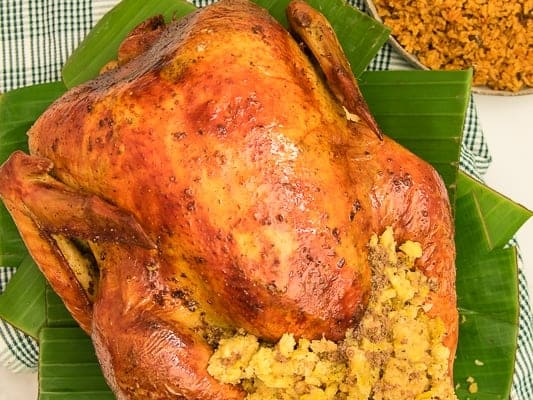
Pavochon with Mofongo Stuffing
at Sense & EdibilityEquipment
- large roasting pan with rack
- dutch oven for frying
- meat thermometer
Ingredients
For the Pavochon Marinade
For the Pavochon (begin 1-2 days ahead)
- 12 pound (5 1/2 kilograms) turkey thawed with giblets and neck removed
- 1/2 cup (125 milliliters) distilled white vinegar or lime juice
- 2 tablespoons (30 milliliters) achiote oil
- 2 teaspoons (7 grams) adobo optional
- fresh banana leaves soaked for 15 minutes (optional)
For the Monfongo Stuffing
- vegetable or peanut oil for frying
- 4 large (545 grams) green plantains peeled and cut into 1-inch thick chunks and soaked in salted water
- 10 ounces (227 grams) pork rinds or 2 5-ounce bags
- 8 cloves (3 tablespoons or 13 grams) fresh garlic peeled and mashed to a paste
- 2 teaspoons (1 gram) dried oregano
- 1/2 teaspoon black pepper
- kosher salt to taste
- chicken stock as needed to moisten the mofongo
Instructions
Prepare the Pavochon Marinade (1-2 days ahead)
- Use a pilón (or mortar and pestle) to crush the pavochon marinade's garlic cloves with the salt, dried oregano, oregano leaves, granulated onion powder, sazón, and black pepper until you create a fine paste. Add the sofrito to the paste in the pilón and use the pestle (or a spoon) to stir these together to make a loose marinade.
Marinate the Turkey (Up to 2 Days Ahead)
- Give the turkey a quick wash under cold water before "washing" it again with white distilled vinegar. Leave the vinegar on the turkey for 10 minutes before rinsing the turkey and drying it thoroughly with paper towels.Put the turkey on a half-sheet pan.
- Separate the skin from the flesh by using your fingers to scrape away the connective tissue (or fibers) that hold the skin to the flesh. Do this all over the breast of the turkey. Try to get as much of the back skin separated from the back of the turkey. Because this is a bonier part of the turkey, you may not fully separate the skin from the flesh. Don't worry too much about the drumsticks or the wings.
- Carefully piercing the meat with a thin boning knife. Try to avoid damaging the skin. Once the skin is separated from the flesh, rub the pavochon marinade over the outside of the turkey, under the skin, and inside the cavity.
- Before putting the turkey in the fridge, wrap it tightly in plastic. Wrap two layers of plastic wrap tightly around the turkey, followed by a layer of heavy-duty aluminum foil.Put the turkey back onto the sheet pan to catch any spills, then allow the turkey to marinate in the refrigerator for 12-48 hours.Alternatively, you can leave the turkey in the pan and cover the turkey loosely in plastic wrap. The meat won't be as flavorful, though.
Roast the Turkey
- Remove the foil and plastic wrapping after marinating the turkey. Set the bird into a lightly-greased rack inside a large roasting pan. Preheat your oven to 325°F (163°C). Lower the middle rack one level.Allow the turkey to warm up for at least 1 hour at room temperature while the oven is heating up.
- Before roasting the turkey, pat the skin down with paper towels. Next, use a pastry brush to brush the achiote oil over the entire surface of the turkey. Sprinkle a generous amount of adobo onto the surface of the turkey.
- Cover the pavochon with clean, damp banana leaves, securing the leaves with butcher's twine or the ribs of the banana leaves. Roast the meat for 2 1/2 hours or according to its size and corresponding time on the chart in the post or in the notes section below.
Make the Mofongo Stuffing While the Pavochon Roasts
- Heat vegetable or peanut oil to 350°F (177°C) in a large cast-iron dutch oven or pot. Drain the brine-soaked plantain chunks, then pat them dry.
- Add the plantain chunks in small batches or 6 or 8 pieces to the oil once it reaches temperature. Fry the plantains in the oil for 3-4 minutes or until a knife pierced into its center meets no resistance.Use a spider or slotted spoon to remove the plantains from the oil and drain them on a bed of paper towels to absorb any excess oil. Continue frying the rest of the plantains until they're all cooked.
- Once the plantains are fried, begin mashing them in batches: 5 or 6 chunks of plantains with a handful of pork rinds, 1 teaspoon of garlic paste, 1/2 teaspoon of oregano, and a pinch of pepper. The mofongo should have the consistency of thick mashed potatoes after smashing it. Add a 1/2-1 cup of room temperature chicken stock to the mofongo if it's too dry. Set the mofongo aside until the turkey comes out of the oven.
Stuff the Pavochon, then Finish Roasting It
- Remove the turkey from the oven one hour before it's finished. See the notes section or the post for cooking times.Unwrap the turkey (if you've covered it in the banana leaves) and use a large spoon to stuff it with the prepared mofongo.
- Use the spoon or a turkey baster to ladle any pan juices over the turkey and mofongo. Return the roasting pan with the turkey to the oven and continue to roast for 45 minutes-1 hour, basting the turkey after 30 minutes.
- Insert a thermometer probe into the turkey breast's thickest part to ensure it's ready. The internal temperature of a fully cooked turkey is 165°F (74°C). Once the pavochon is fully cooked, remove it from the oven and allow it to rest for 30 minutes before carving.
Notes
Swaps and Substitutions:
- You can use a disposable aluminum roaster instead of a roasting pan if it's more convenient.
- Wrap the roasting pan in heavy-duty aluminum foil if you can't find banana leaves.
- You can replace the pork rinds in mofongo with fried chicken skins or omit them altogether.
Tips and Techniques:
- A general guideline for roasting time for all meats can be found on the FoodSafety.gov website.
- Use 1 plantain per diner if you want a lot of stuffing, or reduce it to half per person.
- If you have a potato masher, you can add everything to a 4-quart mixing bowl and use it to mash everything for the mofongo together at once.
- If you find that your turkey wings or breast are growing too dark in the oven, cover them with a layer of heavy-duty aluminum foil.
- When checking the temperature of any large piece of meat, it's essential to ensure that your thermometer's probe is not touching bone. Bones register higher temperatures than flesh does.
- The final rest period allows the meat's juices to settle back into the meat, so they don't run out when you cut it, which dries out the turkey.
- Use a carving knife for carving your pavochon. This type of knife has a thin blade, which gives you those pretty slices.
- An 8-pound turkey feeds 8 people. This is likely only a turkey breast, as most turkeys weigh more than 8 pounds. Because turkey breasts are usually boneless, estimate 8 ounces of turkey per guest.
- A 10-pound turkey feeds 15
- A 12-pound turkey feeds 18
- And a 15-pound turkey feeds 22 people.
- 8-12 pound turkey: 2 hours 30 minutes
- 12-14 pound turkey: 3 hours 30 minutes
- 14-18 pound turkey: 4 hours
- 18-20 pound turkey: 4 hours 30 minutes
Carving Instructions:
- Find the center of the breast and make a deep cut into it down to the bone.
- From there, cut 1/4-inch slices on both sides of that dividing line.
- Turn your carving knife horizontally and cut along the breast bone to release the breast slices.
- Slice the wings and drumsticks from the turkey, then remove the thighs at the hip joint.
- Thinly slice the thighs before serving. Serve the drumsticks and wings straight off the bone.
Storage and Reheating Instructions:
- Store leftover pavochon with mofongo in food storage containers in the refrigerator for 72 hours.
- To reheat leftover pavochon: put the meat in a covered container in the microwave or in a skillet with a small amount of water or turkey stock. Reheat until warmed through.
- To reheat the mofongo, add a small amount of chicken stock to its container and reheat until warm.
-
To freeze leftover pavochon:
- Cool the meat completely before transferring it to a freezer storage bag.
- Freeze the meat for up to six months.
- To thaw frozen turkey meat, put it in the refrigerator for 2 to 3 hours or until it has thawed completely and reheat as instructed above.

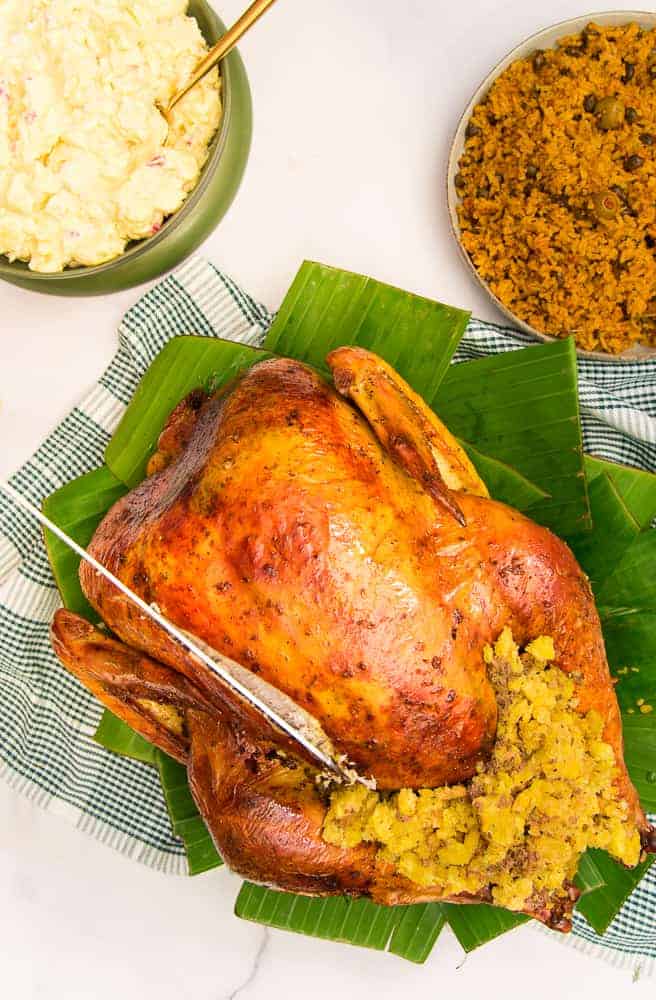

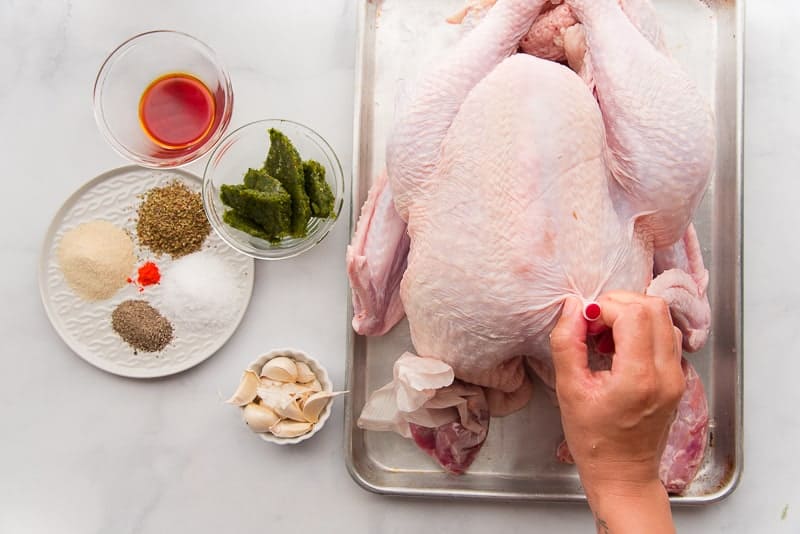
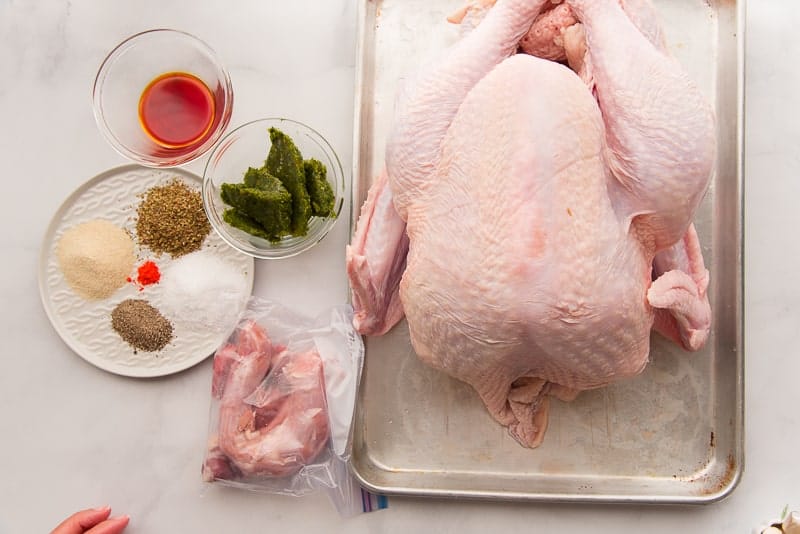
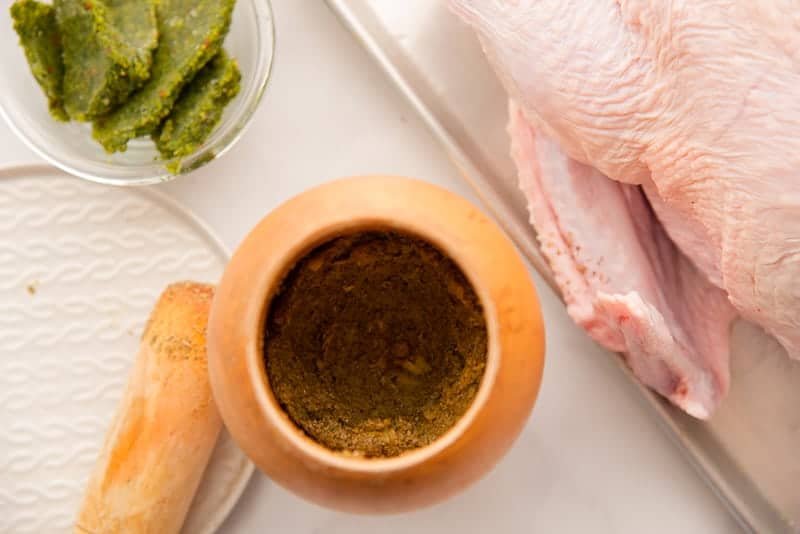
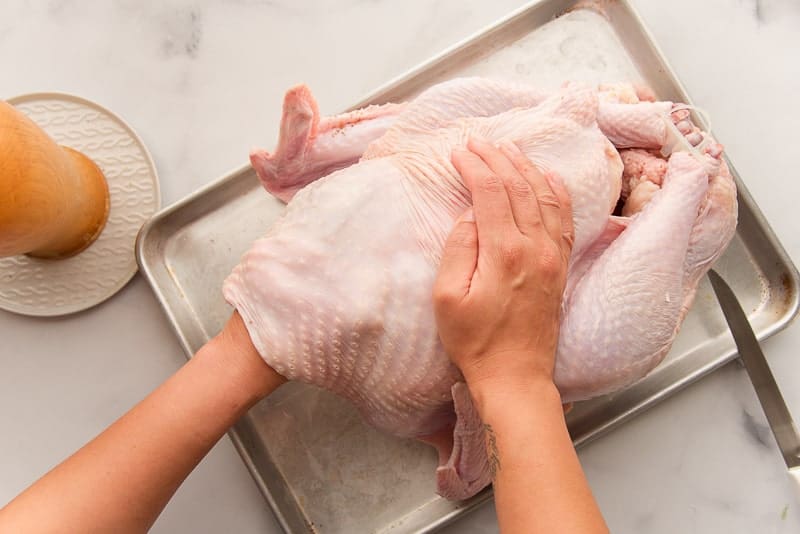
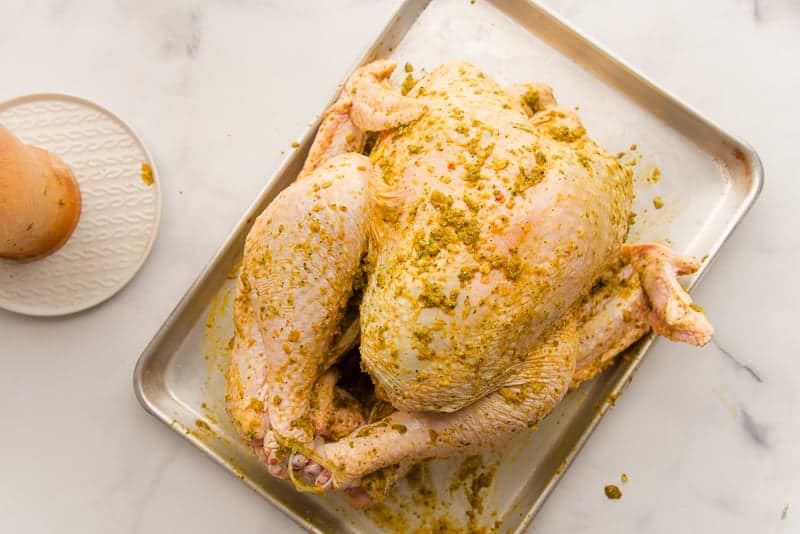
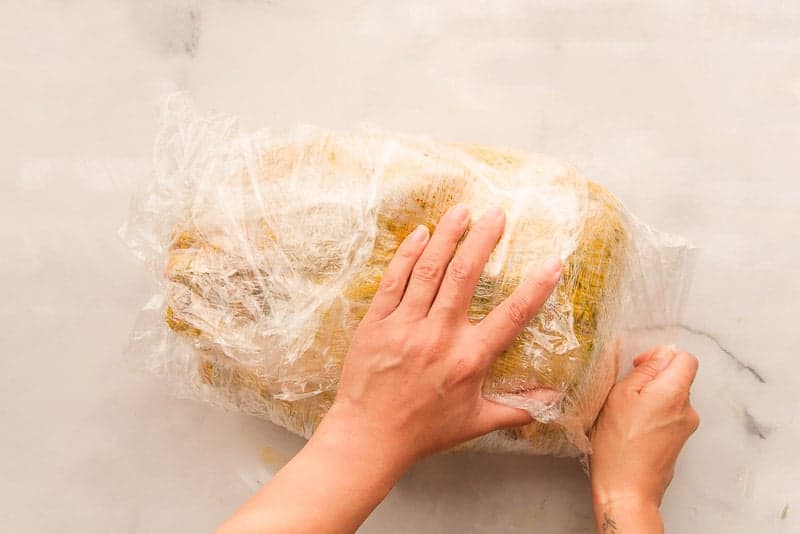
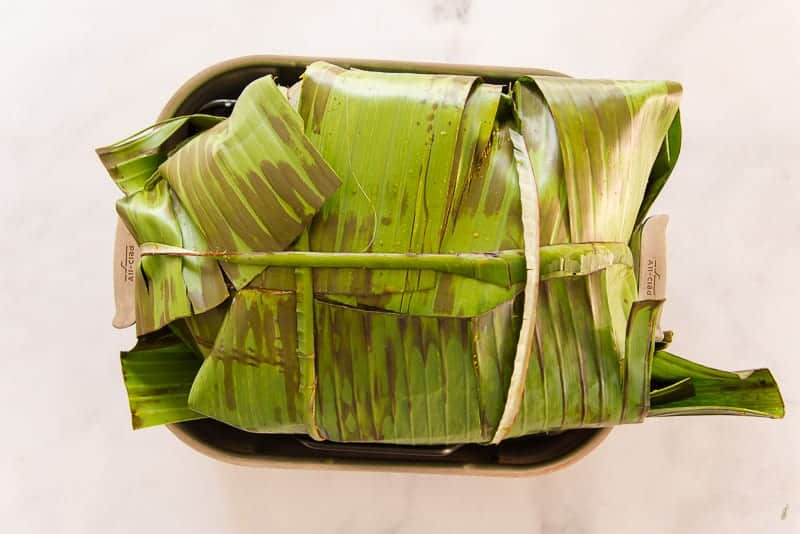
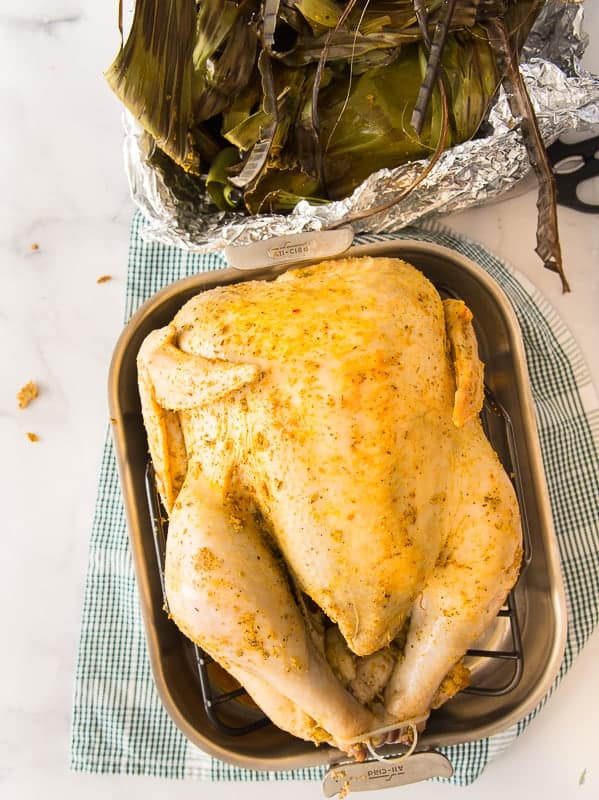




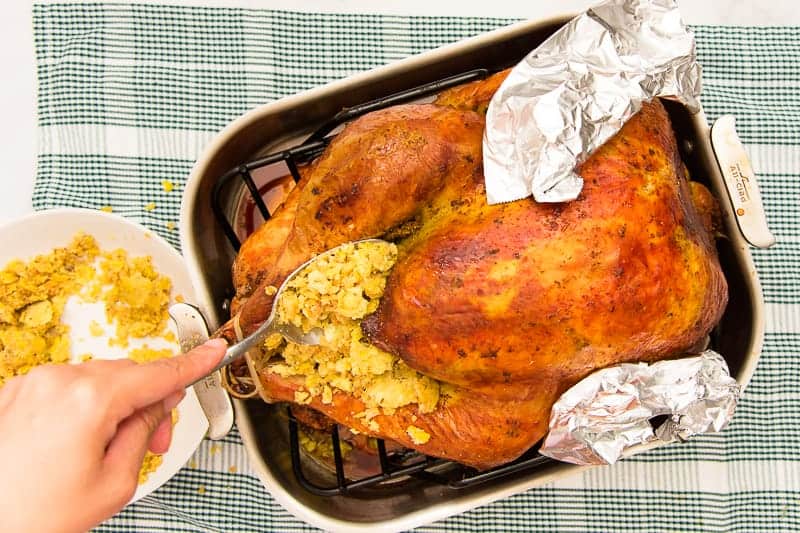
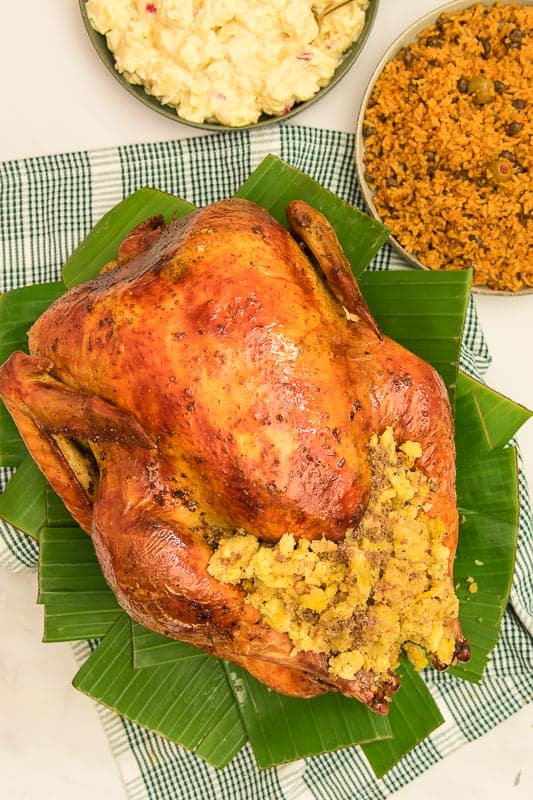
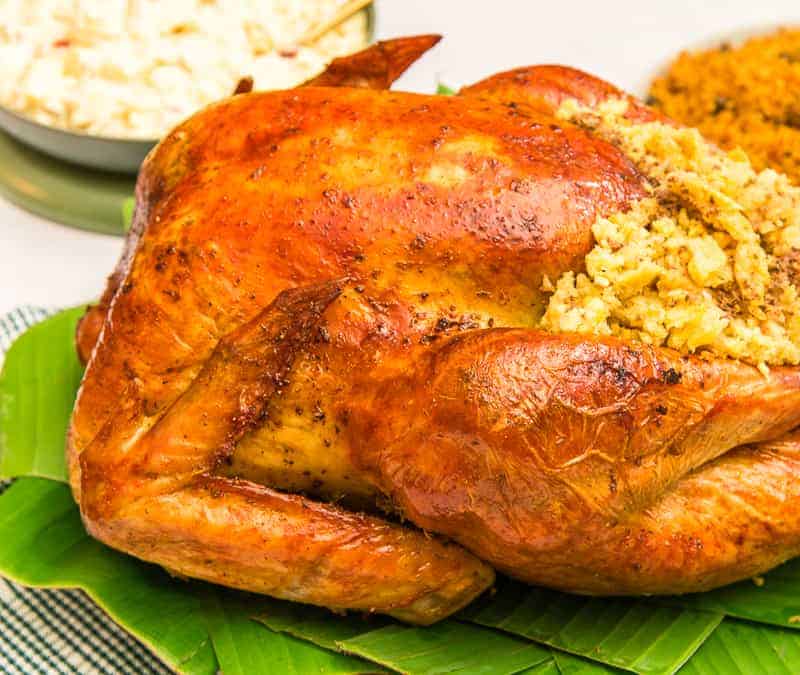
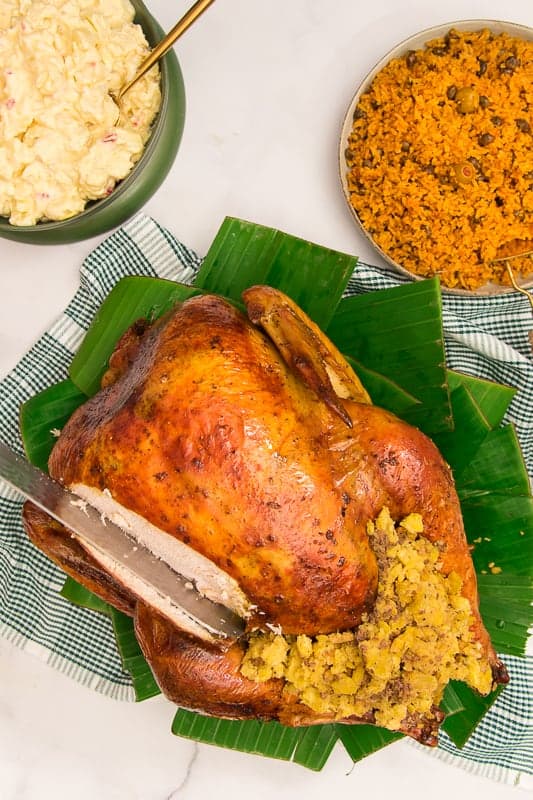
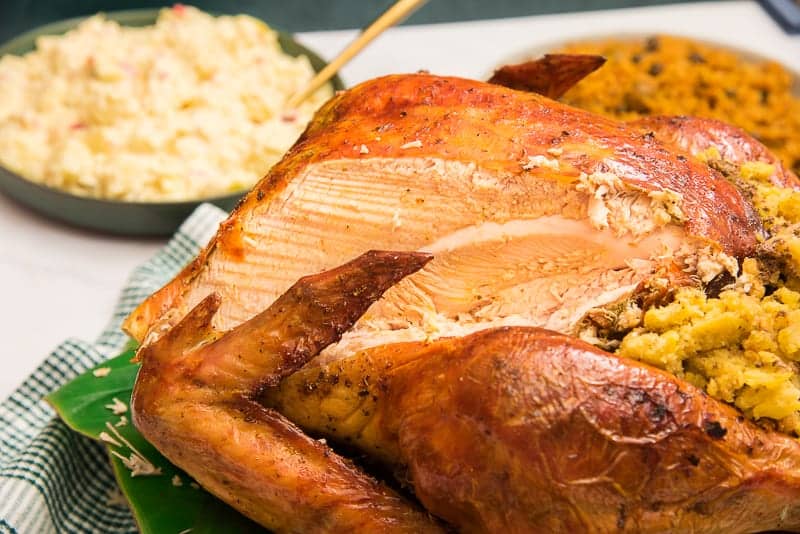
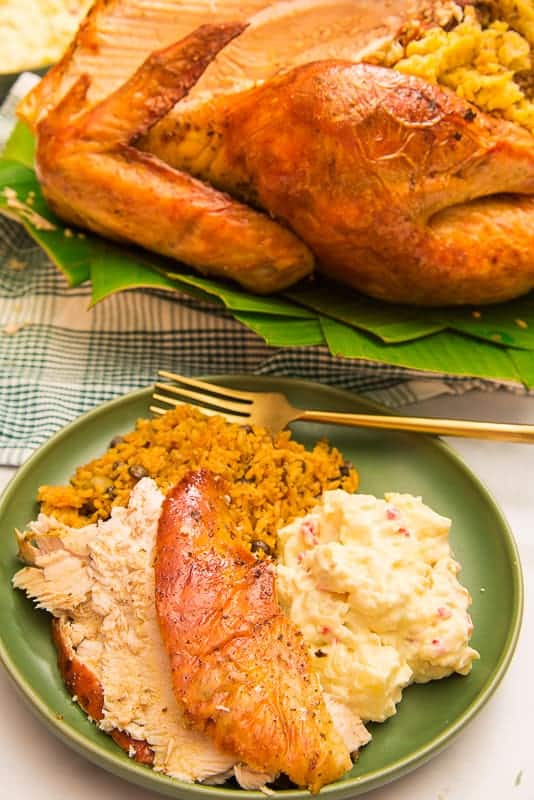
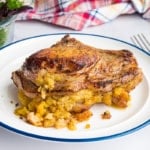
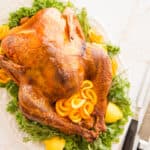



I love doing different turkeys every year, and this pavochon was great! That stuffing…wow. I’m just getting into plantains for so many things, and this was exceptional.
Really glad to know you enjoyed this year’s pavochon, Jessica!
This pavochon was really tasty. I don’t think I’ve ever thought to freeze leftover Thanksgiving turkey but that’s smart, might have to try doing that next year.
For sure! Freezing leftover pavochon is clutch, especially if you’re a busy person. IF there’s any leftover, that is, LOL!
For me this pavochon is new dish and oh boy, this was so amazing. Loved all your detailed information in this post. Must try recipe!
So glad to know you enjoyed it, Hayley!